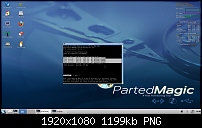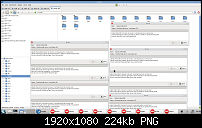|
|
Sponsored Content
Operating Systems
Linux
Slackware
Help with kernel panic - not syncing slackware 13.0
Post 302823989 by ElvijsL on Thursday 20th of June 2013 05:12:34 AM
|
|
10 More Discussions You Might Find Interesting
1. UNIX for Dummies Questions & Answers
hello :-)
I have one problem with my LiLO... I installed PLD Linux on my computer but when it boots, the last thing I can see is:
request_module Root fs not mounted
VFS: Cannot open root device 03:01
Kernel panic: VFS: unable to mount root fs on 03:01
and the system stops :-(
what... (1 Reply)
Discussion started by: pgas
1 Replies
2. Linux
I have compiled kernel version 2.6.12 in my linux box mandrake 10.1. I have followed www.digitalhermit.com/linux/Kernel-Build-HOWTO.html instructions. I have copied .config file from /usr/src/linux and lightly modified it (only the processor type) by xconfig. I have compiled the source and modules.... (3 Replies)
Discussion started by: Davide71
3 Replies
3. UNIX for Dummies Questions & Answers
I am trying to Install RHEL AS 4 on x86 pc, through VNC and got the below error, Am not pretty sure as how to resolve this. Can some one guide me through the process, or what might be missing....
Have Installed RHEL, many a times but cudnt find this out...
Wud appreciate an early reply ......... (0 Replies)
Discussion started by: Crazy_murli
0 Replies
4. Linux
ok so I just installed fedora core 6 on my dell inspiron 700m and I go to boot into linux and I get this error. Has anyone seen this before?
I also had XP Pro and Vista installed on this pc prior to putting fedora core 6 on the machine. I'm trying to setup a triple boot system.
Please Help... (2 Replies)
Discussion started by: dave043
2 Replies
5. UNIX Desktop Questions & Answers
Hi ALL,
I am getting error..
kernal panic-not syncing:fatal exception
while booting.
Please help me..
Thanks
Jack (7 Replies)
Discussion started by: jack00423
7 Replies
6. UNIX for Advanced & Expert Users
Hi, all:
How should I obtain the reason of kernel panic?
How should I debug the program which result in a kernel panic?
What can I get from the panic information?
li, kunlun (3 Replies)
Discussion started by: liklstar
3 Replies
7. Ubuntu
I installed a new kernel 3.0.22 on ubuntu server 11.04 32 bit.
when I select the kenel from boot loader it stops when
Code:
loading initial ramdisk...
I added all_generic_ide at the end of linux line and also added dev/sda1 to linux line: root=UUID=dev/sda1
now it says that
... (12 Replies)
Discussion started by: dr_mabuse
12 Replies
8. Red Hat
HI All,
server stopped here, we are suspecting server crash, need install new OS.
Any suggestions on this. kindly help to us.
Thanks
Rajesh (0 Replies)
Discussion started by: Rajesh_Apple
0 Replies
9. SCO
Hello
when i booting my SCO Server I become this Message
PLS can anyone help me?
Cheers
Christoph (1 Reply)
Discussion started by: cga
1 Replies
10. Red Hat
dear experts linux
i am using RHEL 5.5 run on a physical server.
i am front of a big trouble, the Rhel can't run correctly , it show me this error message in black screen:
reading all physical volumes. this my take a while ..
found volume group "VolGroup00" using metadata type lvm2
9... (1 Reply)
Discussion started by: wassimpb
1 Replies
LEARN ABOUT FREEBSD
mdconfig
MDCONFIG(8) BSD System Manager's Manual MDCONFIG(8) NAME
mdconfig -- configure and enable memory disks SYNOPSIS
mdconfig -a -t type [-n] [-o [no]option] ... [-f file] [-s size] [-S sectorsize] [-u unit] [-x sectors/track] [-y heads/cylinder] mdconfig -d -u unit [-o [no]force] mdconfig -r -u unit -s size [-o [no]force] mdconfig -l [-n] [-v] [-f file] [-u unit] mdconfig file DESCRIPTION
The mdconfig utility configures and enables md(4) devices. Options indicate an action to be performed: -a Attach a memory disk. This will configure and attach a memory disk with the parameters specified and attach it to the system. If the -u unit option is not provided, the newly created device name will be printed on stdout. -d Detach a memory disk from the system and release all resources. -r Resize a memory disk. -t type Select the type of the memory disk. malloc Storage for this type of memory disk is allocated with malloc(9). This limits the size to the malloc bucket limit in the kernel. If the -o reserve option is not set, creating and filling a large malloc-backed memory disk is a very easy way to panic a system. vnode A file specified with -f file becomes the backing store for this memory disk. swap Storage for this type of memory disk is allocated from buffer memory. Pages get pushed out to swap when the system is under memory pressure, otherwise they stay in the operating memory. Using swap backing is generally preferred instead of using malloc backing. null Bitsink; all writes do nothing, all reads return zeroes. -f file Filename to use for the vnode type memory disk. The -a and -t vnode options are implied if not specified. -l List configured devices. If given with -u, display details about that particular device. If given with -f file, display md(4) device names of which file is used as the backing store. If both of -u and -f options are specified, display devices which match the two conditions. If the -v option is specified, show all details. -n When printing md(4) device names, print only the unit number without the md(4) prefix. -s size Size of the memory disk. Size is the number of 512 byte sectors unless suffixed with a b, k, m, g, or t which denotes byte, kilo- byte, megabyte, gigabyte and terabyte respectively. The -a and -t swap options are implied if not specified. -S sectorsize Sectorsize to use for the memory disk, in bytes. -x sectors/track See the description of the -y option below. -y heads/cylinder For malloc or vnode backed devices, the -x and -y options can be used to specify a synthetic geometry. This is useful for construct- ing bootable images for later download to other devices. -o [no]option Set or reset options. [no]async For vnode backed devices: avoid IO_SYNC for increased performance but at the risk of deadlocking the entire kernel. [no]reserve Allocate and reserve all needed storage from the start, rather than as needed. [no]cluster Enable clustering on this disk. [no]compress Enable/disable compression features to reduce memory usage. [no]force Disable/enable extra sanity checks to prevent the user from doing something that might adversely affect the system. [no]readonly Enable/disable readonly mode. -u unit Request a specific unit number or device name for the md(4) device instead of automatic allocation. If a device name is specified, it must be start with ``md'' followed by the unit number. The last form, mdconfig file, is provided for convenience as an abbreviation of mdconfig -a -t vnode -f file. EXAMPLES
Create a 4 megabyte malloc(9) backed memory disk. The name of the allocated unit will be printed on stdout, such as ``md3'': mdconfig -a -t malloc -s 4m Create a disk named /dev/md4 with /tmp/boot.flp as backing storage: mdconfig -a -t vnode -f /tmp/boot.flp -u md4 Detach and free all resources used by /dev/md4: mdconfig -d -u md4 Create a 128MByte swap backed disk, initialize an ffs(7) file system on it, and mount it on /tmp: mdconfig -a -t swap -s 128M -u md10 newfs -U /dev/md10 mount /dev/md10 /tmp chmod 1777 /tmp Create a 5MB file-backed disk (-a and -t vnode are implied): dd if=/dev/zero of=somebackingfile bs=1k count=5k mdconfig -f somebackingfile -u md0 bsdlabel -w md0 auto newfs md0c mount /dev/md0c /mnt Create an md(4) device out of an ISO 9660 CD image file (-a and -t vnode are implied), using the first available md(4) device, and then mount the new memory disk: mount -t cd9660 /dev/`mdconfig -f cdimage.iso` /mnt Create a file-backed device from a hard disk image that begins with 512K of raw header information. gnop(8) is used to skip over the header information, positioning md1.nop to the start of the filesystem in the image. mdconfig -f diskimage.img -u md1 gnop create -o 512K md1 mount /dev/md1.nop /mnt SEE ALSO
md(4), ffs(7), bsdlabel(8), fdisk(8), mdmfs(8), malloc(9) HISTORY
The mdconfig utility first appeared in FreeBSD 5.0 as a cleaner replacement for the vn(4) and vnconfig(8) combo. AUTHORS
The mdconfig utility was written by Poul-Henning Kamp <phk@FreeBSD.org>. BSD
November 30, 2013 BSD

